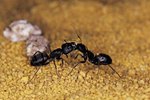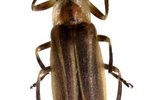Lacewings are easily identified by the transparent wings from which they get their name. Only adults have these wings, though; larvae are voracious little terrors -- just not to you.
Benefits and Dangers
Lacewings are not harmful or dangerous to humans, but they are dangerous to other insects in your garden. At the larval stage, lacewings devour aphids and other pests such as mealybugs, thrips and juvenile whiteflies in massive numbers. Because of this, they are commonly referred to as "aphid lions." Lacewing larvae have long curved mandibles that look as if they could inflict a painful wound, but they do not bite or sting humans. Adult lacewings have mandibles that are in proportion to their bodies; adult lacewings also do not bite or sting humans. Lacewings are considered beneficial insects; they're often intentionally released into gardens that are infested with aphids or other pests.





